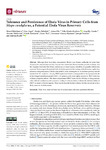Tolerance and Persistence of Ebola Virus in Primary Cells from Mops condylurus, a Potential Ebola Virus Reservoir
Bokelmann, Marcel
Vogel, Uwe
Debeljak, Franka
Düx, Ariane
Riesle-Sbarbaro, Silke
Lander, Angelika
Wahlbrink, Annette
Kromarek, Nicole
Neil, Stuart
Couacy-Hymann, Emmanuel
Prescott, Joseph
Kurth, Andreas
Although there have been documented Ebola virus disease outbreaks for more than
40 years, the natural reservoir host has not been identified. Recent studies provide evidence that
the Angolan free-tailed bat (Mops condylurus), an insectivorous microbat, is a possible ebolavirus
reservoir. To investigate the potential role of this bat species in the ecology of ebolaviruses, replication,
tolerance, and persistence of Ebola virus (EBOV) were investigated in 10 different primary bat cell
isolates from M. condylurus. Varying EBOV replication kinetics corresponded to the expression levels
of the integral membrane protein NPC1. All primary cells were highly tolerant to EBOV infection
without cytopathic effects. The observed persistent EBOV infection for 150 days in lung primary
cells, without resultant selective pressure leading to virus mutation, indicate the intrinsic ability of
EBOV to persist in this bat species. These results provide further evidence for this bat species to be a
likely reservoir of ebolaviruses.
Files in this item

